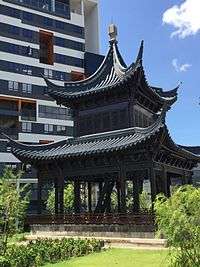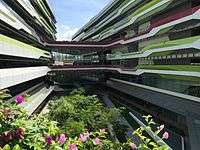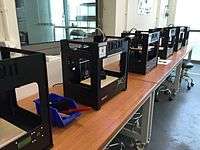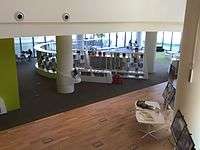Singapore University of Technology and Design
|
新加坡科技与设计大学 (Chinese) Universiti Teknologi dan Rekabentuk Singapura (Malay) சிங்கப்பூர் தொழில்நுட்பம் மற்றும் வடிவமைப்பு பல்கலைக்கழகம் (Tamil) | |
| Motto | A better world by design |
|---|---|
| Type | Publicly-funded Autonomous university[1] |
| Established | 2009 |
| President | Professor Thomas L. Magnanti |
| Provost | Professor Chong Tow Chong |
| Location |
Tampines, Singapore 1°20′24.37″N 103°57′46.64″E / 1.3401028°N 103.9629556°ECoordinates: 1°20′24.37″N 103°57′46.64″E / 1.3401028°N 103.9629556°E |
| Campus | Urban |
| Colours | White, black and red |
| Website | sutd.edu.sg |
 | |
The Singapore University of Technology and Design (SUTD) is the fourth autonomous university to be established in Singapore. SUTD's mission is to advance knowledge and nurture technically grounded leaders and innovators to serve societal needs. At SUTD, design as a discipline cuts across the curriculum and provides a novel framework for the research and educational programmes.
SUTD undergraduate students are granted either a Bachelor of Engineering or a Bachelor of Science degree with a major in one of its four areas of focus, called "pillars": Architecture and Sustainable Design (ASD), Engineering Product Development (EPD), Engineering Systems and Design (ESD) or Information Systems Technology and Design (ISTD). It also offers an MIT–SUTD Dual master's degree programme, a full-time programme leading to a degree from both MIT and SUTD. SUTD also offers Ph.D. degrees in each of its four pillars. SUTD is the only institution in Singapore apart from the Yale-NUS College to follow a holistic admissions process.
History


The university opened its Dover Road interim campus in April 2012. Its permanent campus at Tampines, opened in January 2015. It is the only university to be located in the eastern part of Singapore. The new campus is located next to Upper Changi MRT Station on the Downtown Line Stage 3 which will be operational in 2017. The founding president is Thomas L. Magnanti, who is a Professor with the Massachusetts Institute of Technology (MIT).[2]
SUTD's collaboration with MIT covers the following:
- Development of the undergraduate curriculum
- Co-teaching of subjects by MIT faculty
- Student exchanges
- Recruitment and development of SUTD faculty
- Establishment of a major co-located research centre, SUTD–MIT International Design Centre (IDC)
SUTD and Zhejiang University (ZJU) will also jointly partake in research collaborations to address challenges associated with the world today, in areas such as healthcare, transportation, clean energy and the environment.
Academics
Undergraduate programmes
The Massachusetts Institute of Technology (MIT) has been developing an undergraduate curriculum suited to the local context since the two universities signed the collaboration agreement in January 2010. The curriculum offers a modern engineering and architecture education that crosses traditional departments enabling students to finish eight terms in three and a half years, thus graduating nine months earlier than students from the National University of Singapore (NUS), Nanyang Technological University (NTU) and Singapore Management University. SUTD provides a common curriculum for all students in the first three terms (also referred to as "freshmore" terms). This foundation curriculum requires students to take mandatory classes in the Sciences, Mathematics, Design Thinking, Programming, and Humanities, Arts and Social Sciences (HASS). The Sciences requirement in the common curriculum comprises two semesters of physics, two semesters of calculus, one semester of chemistry, and one semester of biology. The Humanities, Arts, and Social Sciences (HASS) requirement consists of eight semesters of classes in the humanities, arts, and social sciences, including three semesters of common HASS classes. From term 4 onwards, students specialise in one of the four pillars of study: Architecture and Sustainable Design (ASD), Engineering Product Development (EPD), Engineering Systems Design (ESD) or Information Systems and Technology Design (ISTD). Beyond the core subjects, all students have to undertake two 16-week internships, which could include exchange trips to MIT or ZJU.
In their final two semesters, students will also have to complete a capstone project that is a confluence of multiple SUTD pillars. In an actual design situation, crucial projects span multiple disciplines and are too large to be completed by one person. It is with this in mind that students are required to participate in an integrative capstone project in the senior year.
Graduate programmes
A two-year full-time MIT–SUTD Dual master's degree programme will be offered in collaboration with MIT to talented graduates with a keen interest in research in one of the following areas: Civil and Environmental Engineering, Supply Chain Management, or Engineering in Manufacturing. Graduate opportunities also include the SUTD Ph.D. Programme. Candidates will spend up to one year in the USA, and the other year in Singapore, receiving master's degrees from both MIT and SUTD.[3]
With MIT, SUTD has launched joint postgraduate programmes to jump-start research at the university. The Ph.D. programme has a strong emphasis on interdisciplinary and collaborative research, and is enhanced by opportunities for industry internships, overseas research attachments and teaching experience. The initial intake in 2012 included ten post-doctoral researchers. Post-doctorate fellows spend one year at MIT and then another year at SUTD where they conduct research and teach.[4]
Academic pillars


Research initiatives
SUTD–MIT International Design Centre
The International Design Centre (IDC) is based both in Singapore at SUTD, and in Cambridge, Massachusetts, at MIT, with academic and industrial partners from around the world. IDC faculty, researchers and students work together to design devices, products, systems, services and the built environment that address strategic needs of Singapore, the greater Asian region, the USA, and the global community. At the same time, the IDC studies and advances the design process and design science, seeking to develop new tools and methods for design practice and education. The IDC has more than a hundred projects that involve approximately 270 faculty, researchers and students.
IDC is part of a collaboration agreement between SUTD and MIT.[5]

Lee Kuan Yew Centre for Innovative Cities
The Lee Kuan Yew Centre for Innovative Cities (LKY CIC) is one of the first university centres to focus on the integrated use of technology and design to derive solutions for urban planning, design, development and management. The Centre will study the confluence of governance, social management frameworks and technology and design innovations. It is one of five research centres in SUTD. The pioneering model of SUTD, a university without boundaries extends to how it is organised to cross disciplines, and the research strength of LKY CIC is drawn from the multidisciplinary faculty working closely with a core team of research fellows at the Centre.
SUTD–JTC Industrial Infrastructure Innovation Centre
The SUTD–JTC Industrial Infrastructure Innovation (I3) Centre was set up to spearhead research efforts in design, architecture, engineering, and social science.
iTrust Research Centre
iTrust is a multidisciplinary research centre which was established collaboratively by SUTD and the Ministry of Defence. The focus of iTrust is on cyber security. Systems of interest include large infrastructure of national importance (such as power grids, water treatment plants and oil refineries) as well as cyber-devices used in healthcare, including pacemakers, defibrillators, insulin pumps and vagus nerve stimulation implants.
iTrust researchers focus on the development of advanced tools and methodologies to ensure security and safety of current and future cyber physical systems. A strong collaboration with MIT enriches the depth, breadth and quality of research.
O-Lab
Through academic research, SUTD's O-Lab is developing and validating effective approaches to collaborative design across Asia. O-Lab comprises academics and practitioners interested in understanding and enhancing design practices. They work with diverse local and international partners including NGOs, government agencies, academic institutes and community bodies to develop and run participatory design projects. These participatory projects are conducted as action research where O-Lab members, project partners and other stakeholders come together to study their problems scientifically in order to guide, correct, and evaluate their decisions and actions.
Temasek Labs at SUTD
Temasek Labs at SUTD (TL@SUTD) undertakes research and development. The current focus is on areas of defence system design and development, such as unmanned systems, information systems, soldier systems and engineering systems.
TL@SUTD complements the work that is currently undertaken at the DSO National Laboratories, NUS, NTU and other research establishments.
City Form Lab
The City Form Lab (CFL) is an urban design research group led by a group of architects, city planners, spatial analysts, programmers, sociologists and artists, which focuses the physical structures of contemporary built environments.[6] It was founded by Andres Sevtsuk at MIT in 2010 as the City Form Research Group, and moved to SUTD in fall 2011. The lab develops software tools for researching urban form and land use patterns;[7] uses spatial analysis and statistics to investigate how the physical form of urban infrastructure affects the social, environmental and economic quality of urban environments; and develops creative design and policy solutions for contemporary urban challenges.[8]
CFL's recent projects include the open-source Urban Network Analysis Toolbox for ArcGIS,[7] the SUTD Gridshell Pavilion,[8] samples of urban fabric in Bugis and Punggol in Singapore, and the exhibit at the 2013 Tallinn Architecture Biennale.
Campuses
The interim campus for Singapore University of Technology and Design from April 2012 was at Dover, Singapore. SUTD's permanent campus opened in January 2015 at Changi, near Changi Business Park.[9] SUTD appointed, through an open selection process, DP Architects Pte. Ltd. in collaboration with UNStudio from Amsterdam to design the academic cluster of its permanent campus in Upper Changi.
See also
References
- ↑ "Post-secondary education". Ministry of Education, Singapore. Ministry of Education, Singapore. Retrieved June 11, 2015.
- ↑ "4th university named as Singapore University of Technology and Design". Channel NewsAsia. Retrieved 27 March 2011.
- ↑ "Singapore University of Technology and Design (SUTD) at Changi, Singapore: Transportation Engineering and Logistics & Supply Chain Management Education". EduMaritime.com. Archived from the original on 22 February 2015. Retrieved 4 June 2015.
- ↑ Tracy Quek (13 September 2010). "Joint postgrad programme". The Straits Times. Retrieved 27 March 2011.
- ↑ Jeremy Koh (25 January 2010). "New International Design Centre to be established at SUTD". Channel NewsAsia. Retrieved 27 March 2011.
- ↑ Carolyn Y. Johnson (3 October 2011). "A new toolbox for urban analysis: Researchers look to new data, tools to better plan successful cities". The Boston Globe. Archived from the original on 3 March 2014.
- 1 2 Michael J. Coren (8 September 2011). "MIT's free urban planning software will help build the cities of the future". Fast Company. Archived from the original on 11 November 2014.
- 1 2 "SUTD Library Pavilion by City Form Lab". Dezeen. 15 June 2013. Archived from the original on 18 November 2014.
- ↑ "Campus Life: A Campus Built for Interaction and Collaboration: East Coast Campus". Singapore University of Technology and Design. Archived from the original on 17 March 2015. Retrieved 17 March 2015.
External links
| Wikimedia Commons has media related to Singapore University of Technology and Design. |
- Official website of the Singapore University of Technology and Design
- Urban Network Analysis Toolbox developed by the City Form Lab, SUTD